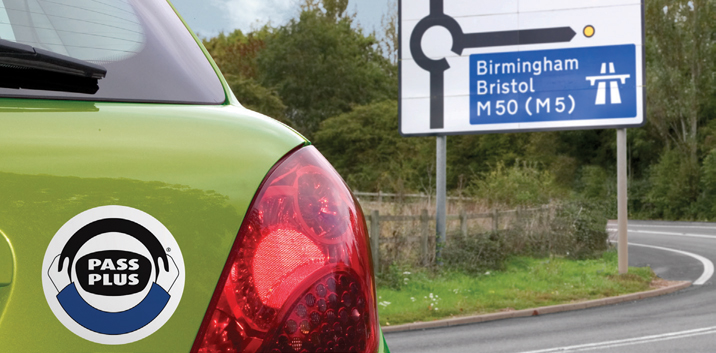This section covers
This section covers
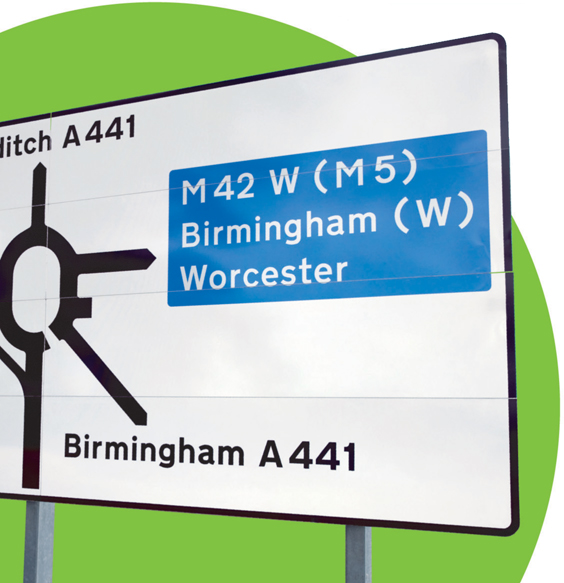
Motorways differ from ordinary roads in that they’re designed to help traffic travel faster and in greater safety. This puts greater demands on both driver and vehicle.
Motorways are statistically safer than other roads in relation to the number of incidents occurring. However, when they do happen, motorway incidents usually occur at higher speed and involve more vehicles. As a result, injuries are usually more serious – often with greater loss of life.
Because traffic travels faster, conditions change more rapidly. You need to be alert and have total concentration.
•Car drivers must hold a full driving licence.
•You should have a thorough knowledge of all rules within The Highway Code but particularly those dealing with motorways.
•You need to know and understand motorway warning signs and signals.
You need to be fit and alert to drive anywhere, but particularly on motorways. Never use the motorway if you feel tired or unwell.
General guidelines on dealing with fatigue are given on page 19 but the problems when driving on motorways tend to be greater because of the long distances and the monotony of the journey.
Research has found that fatigue accounts for 15–20% of incidents on monotonous roads (especially motorways). These tend to result in more serious injury than the average collision because of the high speed of the impact (there’s often no braking beforehand).
If your journey seems monotonous and you feel drowsy, keep a window open until you reach a service area. Plan plenty of rest stops, especially at night.
Parking is forbidden except at service areas. If you need rest, you’ll sometimes have to travel a long distance before an exit or a service area. Remember it’s an offence to stop on the hard shoulder, an exit or a slip road, except in an emergency.
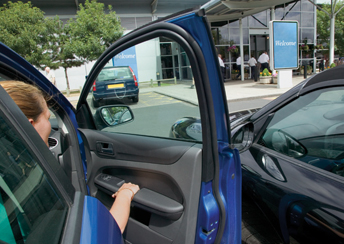
Stop at a service area if you need a rest.
You must only drive a vehicle that is allowed on a motorway and make sure your vehicle is safe and in good working order.
The following types of vehicle mustn’t be used on the motorway
•motorcycles under 50 cc
•certain slow-moving vehicles with oversized loads – except with special permission
•invalid carriages less than 254 kg unladen weight
•agricultural vehicles.
Also, motorways MUST NOT be used by pedestrians, cyclists, horse riders or holders of provisional car and motorcycle licences.
Before you use the motorway High speeds and long distances increase the risk of mechanical failure.
You should carry out the following checks on your vehicle.
•Tyres They must be in good condition and inflated to the correct pressure. Follow the guidance given in the vehicle handbook which may give different pressures to be used when the vehicle is loaded.
•Brakes Check they can stop you safely.
•Steering Check it’s in good order.
•Instruments and warning lights Make sure they’re all working correctly.
•Mirrors Make sure they’re clean and correctly positioned.
•Windscreen and windows Make sure they’re clean. Top up the reservoir for the windscreen washers, and the rear window washer, if your vehicle has one.
•Lights and indicators Make sure they’re all working correctly.
For safety, convenience and good vehicle care you should also check the following items.
•Fuel Make sure you have enough fuel to avoid running out between service areas.
•Oil High speeds may mean your engine uses oil faster. Running out can be dangerous and costly.
•Water Higher speeds can mean a warmer engine, especially in traffic tailbacks in hot weather.
Make sure your load is secure Check that everything carried on your vehicle or trailer is safe and secure. If anything should fall from your vehicle or from another, stop on the hard shoulder and use the emergency telephone to inform the authorities. Never try to retrieve it yourself.
Leading to the motorway Direction signs from ordinary roads to the motorway have white lettering and figures on a blue panel, often bordered in white.
These signs may stand alone or be included in other larger signs of various colours.
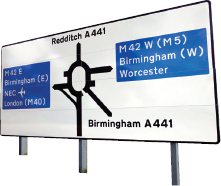
On the motorway You may find the following types of sign on the motorway
•advance direction signs
•countdown markers
•signs giving information about service areas
•signs with a brown background. These indicate tourist attractions which can be reached by leaving at the next exit.
All these signs are very much larger than those on ordinary roads because you need to be able to see them from a distance. This is a good reminder that you must leave more room for all manoeuvres on motorways.
Each junction has an identifying number which corresponds with current road maps. This is to help you plan your route and know where you need to leave the motorway.
Speed limit signs
•Signs that display a speed limit within a red ring indicate mandatory maximum speed limits. You MUST obey these signs. If you don’t, you risk prosecution.
•Black and white rectangular signs recommend maximum speed limits which you MUST observe.
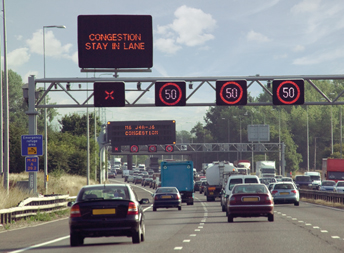
Signals warn of dangers ahead, such as
•incidents
•fog
•icy roads
•delays
•standing traffic.
Flashing amber lights Look out for flashing amber lights and signs, either on the central reservation or overhead. These warn you of
•lane closures
•roadworks
•other hazards.
They might also show a temporary maximum advisory speed limit. You should
•slow down to the speed limit
•be ready to slow down even further to pass the obstacle or danger
•look out for signs giving further advice
•don’t speed up until you see the sign ending the temporary restriction (or there are no more flashing amber lights).
Red lights Some signs have flashing red lights as well.
A red light (it may be a red ‘X’) warns you that you MUST NOT go beyond the red light in that lane. You should
•start to slow down in good time
•be ready to change lanes.
If the red light flashes on a slip road, you MUST NOT enter it.
If a red light flashes on the central reservation or at the side of the road, you MUST NOT go beyond the signal in any lane.

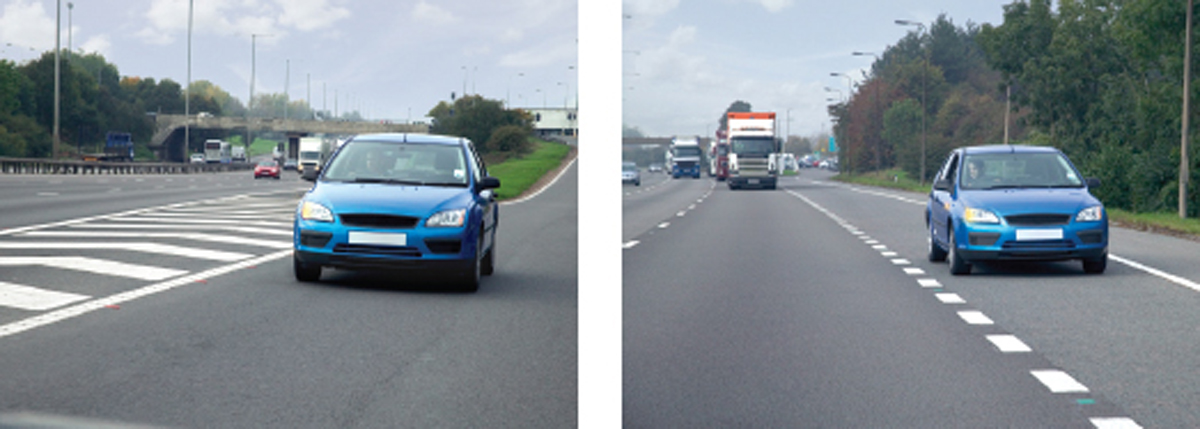
You can get onto a motorway
•where a main road becomes a motorway. This is indicated by a specially worded sign
•by joining at any entry point. A slip road leads onto the motorway.
At an entry point where a slip road leads to the motorway, adjust your speed to that of the traffic already on the motorway before joining it. Give priority to traffic already on the motorway.
Join where there’s a suitable gap in the left-hand lane. Use the MSM/PSL routine.
A quick sideways glance might be necessary to verify the position of other vehicles. Try to avoid stopping at the end of the slip road unless queuing to join other slow-moving traffic.
At some slip roads there’s no need to join by merging because the joining lane may continue as a dedicated lane. Signs and road markings normally indicate this arrangement.
Do
•indicate your intention to join the motorway
•make sure you can be seen
•assess the speed of the traffic on the motorway before you try to join.
Don’t
•force your way into the traffic stream
•drive along the hard shoulder.
Once you’ve joined the motorway, keep in the left-hand lane* until you’ve had time to judge and adjust to the speed of the traffic already on the motorway.
*In a very few cases, the lane merges from the right. Take extra care when joining or meeting traffic at these locations.
Make sure you start out with clean mirrors, windscreen, windows and lights. Use your washers, wipers and demisters whenever necessary to ensure you can see clearly.
You need to use your mirrors frequently and much earlier than on normal roads. Because of the higher speeds on motorways, they’re even more important.
Always try to avoid staying where you might be in another vehicle’s blind spot. This is especially important when the other vehicle is a large vehicle. A good indication is if you can’t see the driver’s mirror, the driver probably won’t be able to see you.
Keep your eyes moving between the road ahead and your mirrors, so that you always know what’s happening all around you.
Continually reassess the movement of the vehicles
•directly ahead (in the near and far distance)
•alongside you
•behind you.
At high speeds, situations change rapidly. Effective observation helps you prepare for any sudden developments.
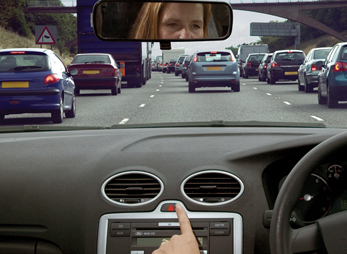
For example, an increase in the number of vehicles ahead could mean that traffic is slowing down and ‘bunching’. A flashing breakdown light will warn you to slow down until you’re sure of what’s happening.
If you see serious congestion ahead, you can use your hazard warning lights briefly to alert drivers behind you. This can reduce the risk of rear-end collisions, especially in bad weather.
Because of the higher speeds, your vehicle must be seen much earlier on a motorway than on an ordinary road.
Poor daylight In poor daylight, you should use your headlights.
Fog In fog, where visibility drops below 100 metres (328 feet), you may find it helpful to use fog lights in addition to your headlights.
You MUST switch your fog lights off when visibility improves. This is the law. They’re misleading and can dazzle other drivers if left on. They may also make your brake lights less conspicuous.
Headlight flashing The level of noise is higher on a motorway, particularly in wet weather, and other road users may not be able to hear your horn.
If you think a warning is necessary, flash your headlights instead.
Watch out for any such warnings intended for you.
At motorway speeds, braking should normally be
•unhurried
•progressive.
If you slow down gradually without putting your foot on the brake, it allows traffic to move more freely. If you’re constantly touching the brake pedal and causing your brake lights to show, it encourages those behind to do the same, causing braking and accelerating, so hindering smooth flow of traffic.
Following traffic at the correct distance will enable you to adjust your speed without having to constantly brake and accelerate heavily. This will aid the smooth flow of traffic.
It’s when you’re driving on a motorway that you may find it most useful to use cruise control if it’s fitted (see page 60). This will help you to maintain a constant speed and may help you save fuel.
•Anticipate problems; take avoiding action before they develop.
•Slow down in good time.
•Keep your distance from the vehicle ahead.
•Take particular care when overtaking lorries, as some have poor visibility to their right.
Never brake suddenly Defensive driving will reduce the likelihood of having to do so.
Remember, leave plenty of space between yourself and the vehicle ahead for controlled braking. Always check in your mirrors before you brake.
The faster the traffic, the more time and space you need for every driving action.
You should always
•give yourself greater margins than on ordinary roads
•make sure there’s enough space between you and the vehicle ahead.
Traffic normally travels faster because there are usually no
•ordinary junctions
•sharp bends*
•roundabouts*
•steep hills (see page 232)
•traffic lights.
Slow-moving vehicles are generally forbidden.
*Some motorway links, where motorway regulations also apply, have roundabouts and sharp bends.
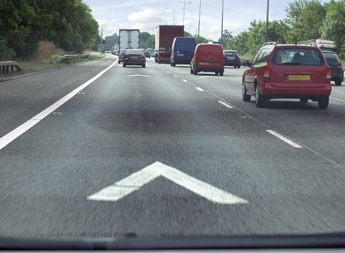
How big a gap? Leave a gap of at least one metre or yard for each mph of your speed. A useful method of judging this is to use the two-second rule described on page 140.
This rule is reinforced on some motorways where there are chevrons painted on the carriageway. Keep at least two chevrons between you and the vehicle in front.
Bad weather Leave at least double the space if the road is wet.
In icy conditions, you’ll need up to 10 times the stopping distance that you do for dry conditions.
Tailgating This is a very dangerous practice, especially on motorways, where it’s often the cause of serious incidents.
Lane discipline is vitally important on motorways. You should normally drive in the left-hand lane.
On a two-lane motorway, the correct position for normal driving is in the left-hand lane.
The right-hand (offside) lane is for overtaking only. Once you’ve overtaken you should return to the left-hand lane as soon as it’s safe to do so. It’s not the ‘fast lane’.
Large goods vehicles are permitted to use either lane.
Because of the volume of traffic on three-lane motorways, many are being widened to four or more lanes in each direction.
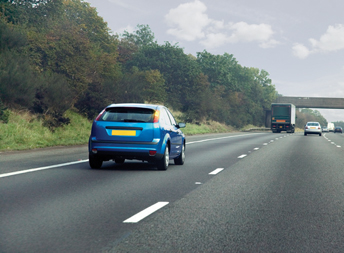
Keep to the left-hand lane unless there are a great many slower vehicles ahead – it’s possible to stay in the centre or outer lanes while you’re overtaking a number of slower moving vehicles, but don’t stay in these lanes
•longer than you have to
•if you’re delaying traffic behind you.
Drivers of large goods vehicles, buses, coaches or any vehicle towing a trailer aren’t allowed to use the extreme right-hand lane of a motorway with more than two lanes, unless one or more lanes are temporarily closed.
Don’t stay in an overtaking lane longer than it takes you to move out, overtake and move in again safely. Make sure you don’t block traffic that’s not allowed to use the outer lane.
Don’t change lanes unnecessarily. You should
•keep your vehicle steady in the centre of the lane
•not wander into another lane.
MSM routine Always use the MSM routine well before you intend to change lanes.
At higher speeds, you must start the routine much earlier.
Look and, if necessary, signal in good time. Remember vehicles might come up behind you very quickly.
The sooner you indicate, the sooner other drivers are warned of your intended movement. They’ll expect a change in the traffic pattern and have time to prepare for it.
Be particularly aware of motorcyclists; they can be difficult to see due to their narrow profile but they may be travelling at high speeds. In congested situations they may filter between lanes of slower-moving traffic.
A steep hill on a motorway might have a crawler or climbing lane to avoid heavy vehicles slowing down the flow of traffic.
These motorways generally have signs advising drivers not to change lanes.
After you pass an exit, there’s usually an entrance where other vehicles can join.
•Don’t try to race them while they’re on the slip road.
•Look well ahead; if there are several vehicles joining the motorway be prepared to adjust your speed.
•Show consideration for traffic joining the motorway and if it’s safe, move to another lane to make it easier for joining traffic to merge.
•Take extra care if the motorway curves as drivers on the slip road may have difficulty seeing vehicles on the motorway.


Where motorways merge or separate you might be required to change lanes, sometimes more than once.
Pay attention to the overhead direction signs and move into the correct lane in good time.
Where the hatch markings indicate splitter islands, stay in your lane.
Assess conditions well ahead and watch for other drivers changing lane.
Traffic conditions can vary as much on a motorway as on an ordinary road.
There can be rush hour traffic near cities, heavy traffic near roadworks and constantly busy sections in other places.
These differences will be more noticeable on two-lane motorways.
React to changes well in advance. Don’t wait until you’re forced to react.
Further information on lane discipline for other road types can be found in section 7.
Leave a safe distance between you and the vehicle you intend to overtake.
Use the appropriate parts of the MSM/PSL routine. For example
Mirror Check behind to verify the speed, course and position of traffic behind you.
Position You should be able to move out smoothly to the right without making any sudden movements.
Speed Make sure you’re going fast enough or can accelerate quickly enough to overtake without blocking any vehicle coming up behind.
Look Look ahead and use your mirror to check if there’s anything preventing you from overtaking safely; for example, a lane closure ahead or traffic coming up much faster from behind in the right-hand lane.
Try to anticipate whether the vehicle ahead will move out to overtake.
A quick sideways glance into the blind area might sometimes be necessary before you change lanes.
Remember LADA
•Look
•Assess well ahead
•Decide – don’t rush
•Act – only when you’re sure it’s safe.
Mirrors You must use your mirrors regularly and sensibly.
Remember that vehicles coming up in the right hand lane are likely to be moving faster than you are. Watch out particularly for motorcyclists as they’re more difficult to see. Watch for vehicles returning to the lane you intend to use.
Signal You must signal well before you start to move out. This gives drivers behind you plenty of time to anticipate what you intend to do and could influence any manoeuvres they’re planning.
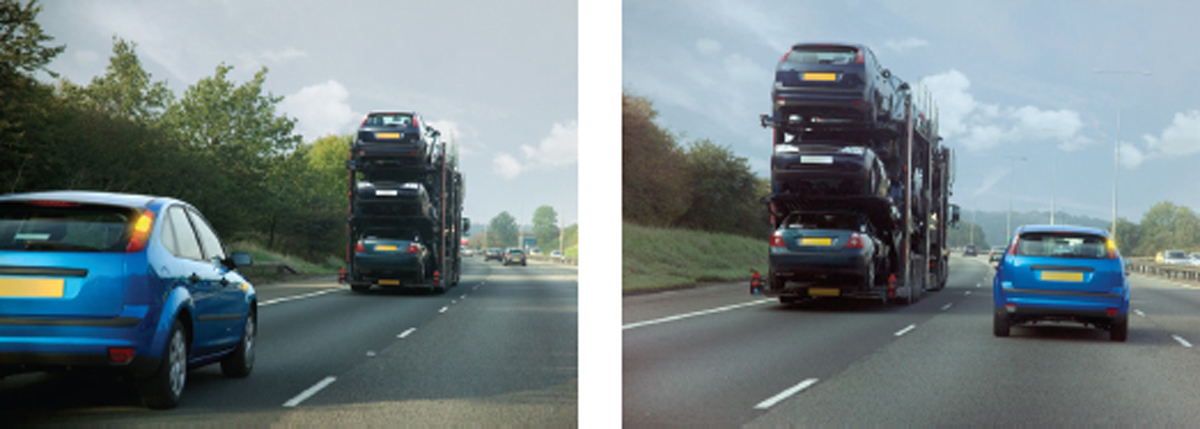
Check your mirrors again, and take a quick sideways glance into the blind spot, before pulling out smoothly into an overtaking lane. Overtake as quickly and safely as possible.
Pass the vehicle and signal, if necessary, before moving back into the left as soon as you’re sure it’s safe to do so. Don’t cut in too soon in front of the vehicle you’ve just passed.
Look well ahead for any vehicles about to move out into the lane into which you intend to move. Allow plenty of room. Finally, make sure your indicator signal cancels properly.
Never overtake on the left, unless the traffic is moving in queues and the queue on your right is moving more slowly than the queue you’re in.
If you come up behind traffic moving more slowly than you are when you’re overtaking, be patient and
•don’t intimidate the driver ahead by repeatedly flashing your headlights and driving dangerously close behind
•wait until the vehicle ahead can move safely to the left, then proceed.
Let faster traffic pass you. If other drivers are breaking the speed limit, don’t add to the danger by trying to enforce the legal speed limit. Don’t move to a lane on the left to overtake.
Never use the hard shoulder to overtake – unless directed to do so by traffic signs at roadworks, by police officers or Highways Agency traffic officers in uniform.
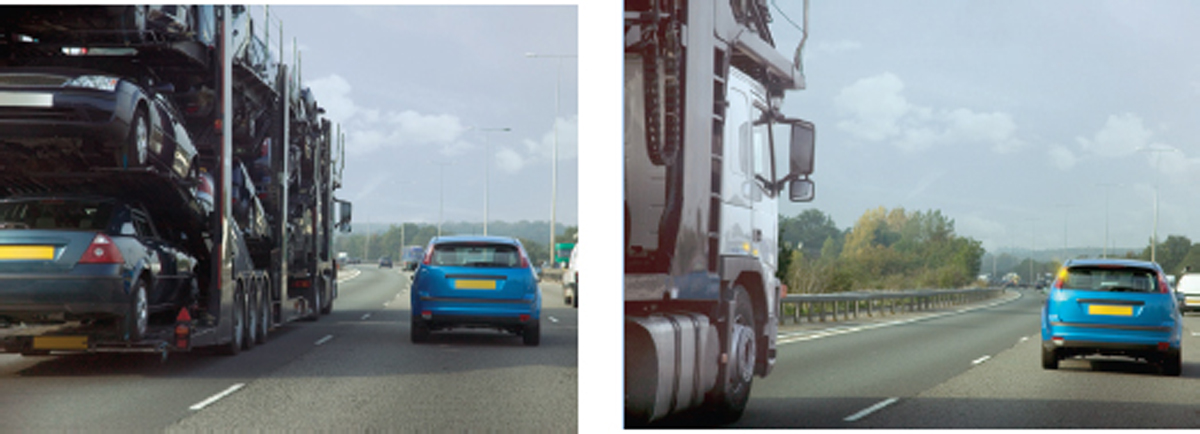
Unless you’re going to the end of the motorway, you’ll leave by moving left from the left-hand lane into the slip road. Position yourself in the left-hand lane in plenty of time.
Plan well ahead, particularly on motorways with three or four lanes.
Use the road signs and markers to help you time your exit and use your mirrors and indicators appropriately.
You’ll have plenty of time to observe the signs and markers so there’s no need to rush.
One mile before the exit A junction sign with road numbers, unless there are exits very close together.
Half a mile before the exit A sign with the names of places accessible from that exit.
Countdown markers These are positioned at 270 metres (300 yards), 180 metres (200 yards) and 90 metres (100 yards) before the start of the slip road.
Where a lane splits off from the motorway as a dedicated lane, countdown markers aren’t provided.
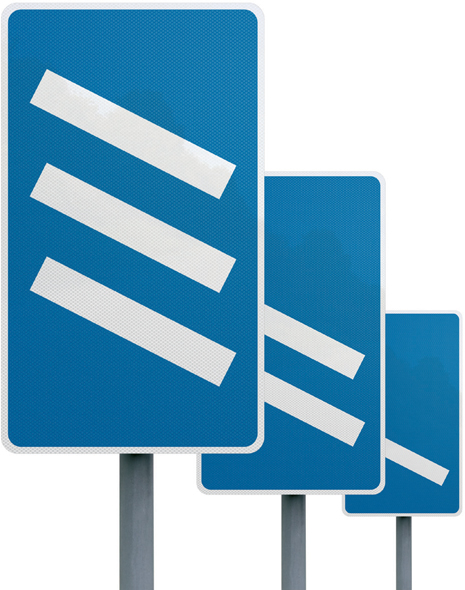
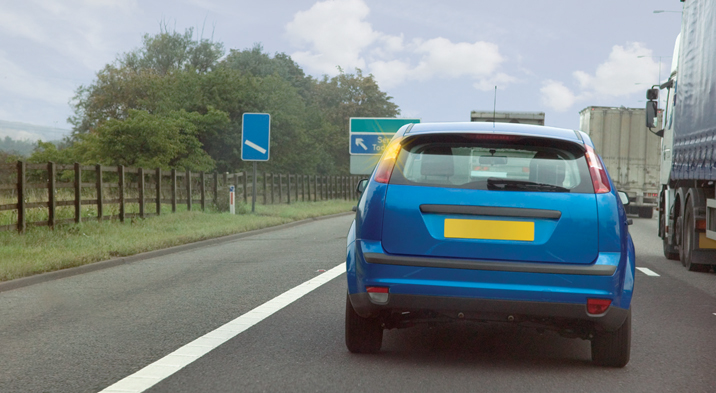
Use your mirrors and signal in good time. Remember to use the MSM/PSL routine.
Get into the left-hand lane early, unless you’re already in it.
On a motorway with three or four lanes, this could mean changing lanes more than once. You must follow the MSM/PSL routine for each change of lane.
Remember, use your mirrors and signal left in good time to move into the left-hand lane.
Don’t
•cut straight across into the slip road
•move to the left more than one lane at a time
•cut across at the last moment, especially from the second lane of a three- or four-lane motorway.
The hard shoulder is not an exit road, and you must avoid queuing on it.
Occasionally, where motorways merge, there may be an exit just before the one you intend to take. In these cases, or where there are service areas near to exits, look well ahead for the advance warning signs.
If you miss your exit, carry on to the next one.
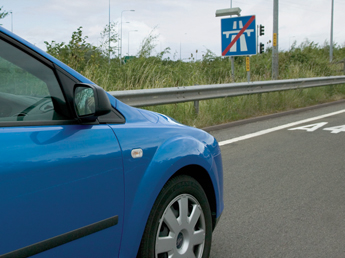
There will be ‘end of motorway’ signs at all exits. These mean that the road you’re joining may have different rules.
Remember to watch for any signs telling you what these are, particularly
•speed limits
•a dual carriageway
•two-way traffic
•a clearway
•a motorway link road
•part-time traffic lights.
Remember, because of the change in traffic conditions you need to watch for pedestrians, cyclists and other road users who are prohibited on motorways.
After driving at motorway speeds for some time, your judgement of speed will almost certainly be affected; 40 or 45 mph (60 or 72 km/h) will seem more like 20 mph (32 km/h). Stay aware of your speed.
•Adjust your driving to suit the new conditions.
•Check your speedometer. It will give you the accurate speed.
Remember, even if you don’t have to reduce your speed because the road you’re joining is a dual carriageway, drivers of some other vehicles have to conform to a lower speed limit. Be aware, therefore, that they may reduce their speed.
For the sake of safety, reduce your speed until you’re accustomed to the change of conditions. It could take you time to adjust.
Motorway slip roads and link roads often have sharp curves which should be taken at much lower speeds.
Look ahead for traffic queuing at a roundabout or traffic signals.
The advice given in section 12 (all-weather driving) is even more important on a motorway.
Visibility can be made worse because at higher speeds, vehicles, especially large ones, throw up more spray. So
•use your headlights to help other drivers see you. Don’t use rear fog lights unless visibility is less than 100 metres (328 feet)
•always reduce your speed when conditions are poor. Driving is safer at lower speeds
•adjust your speed to suit the conditions and leave larger separation distances, at least double the normal gap.
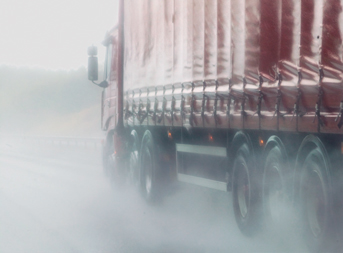
The presence of ice or frost can seriously affect your handling of the vehicle.
Try to anticipate the road surface conditions. If your steering feels light, it’s an indication that there may be frost or ice. A very gentle touch on your brakes to see their response could help you judge the road surface conditions.
Allow up to 10 times the distance for braking.
Wind is another motorway hazard.
Wind can affect your steering. If it’s coming from the left on an exposed stretch of motorway, be especially careful. A sudden gust as you pass a large vehicle, or come out from under the shelter of a bridge or embankment, can send you swerving to the right.
In strong wind, drivers of high-sided vehicles or those towing caravans are likely to experience difficulties. Motorcyclists are also often seriously affected by strong crosswinds. Allow for this when overtaking these vehicles.
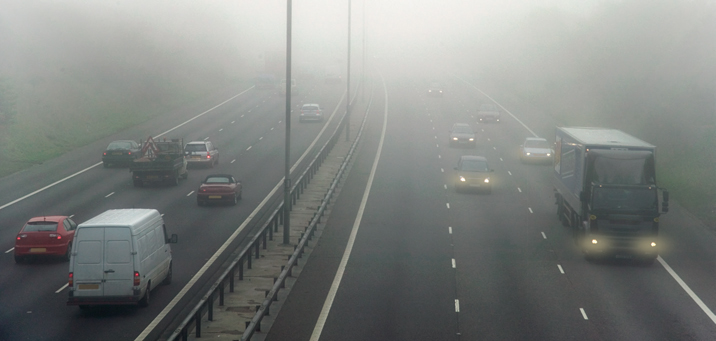
Driving on the motorway when the weather is foggy can be particularly hazardous.
If there’s fog on the motorway, you must be able to stop well within the distance you can see to be clear.
•Use dipped headlights.
•Check your mirrors and slow down; fog affects both visibility and judgement of speed and distance.
•Check your speedometer and leave plenty of space between your vehicle and the vehicle ahead.
Fog can drift quickly and is often patchy.
If a motorway warning sign shows ‘FOG’
•be prepared
•reduce speed in good time.
Unfortunately, multiple pile-ups are all too common in foggy conditions. They don’t just happen. They’re caused by drivers who are
•travelling too fast
•driving too close to the vehicle in front
•assuming there’s nothing in the fog ahead
•ignoring the obvious!
If there’s fog
•switch on your fog lights if visibility drops below 100 metres (328 feet)
•be prepared to leave the motorway
•be on the alert for incidents ahead
•watch out for emergency vehicles coming up behind, possibly on the hard shoulder.
Remember, don’t ‘hang on’ to the lights of the vehicle ahead. You’ll be too close to brake if it stops suddenly.
You must only stop on a motorway if
•red lights or other signs or signals tell you to do so
•you’re asked to stop by the police, Highways Agency traffic officers or Vehicle and Operator Services Agency officers
•it’s an emergency
•it will prevent an incident.
You mustn’t stop to pick up or set down anyone on any part of a motorway, including a slip road.
The hard shoulder Use the hard shoulder only in an emergency.
If you have to slow down or stop on the carriageway as a result of traffic congestion, switch on your hazard warning lights to warn traffic behind you of the obstruction ahead. Once you’re sure they’ve been seen, switch them off.
Information about how to deal with breakdowns and incidents on a motorway can be found in section 15, page 289 and section 16, page 295 respectively.
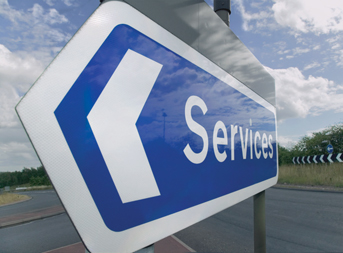
Service areas are the only parking places provided on motorway routes. To reach the services, follow the same procedure as for a motorway exit.
Once you’re off the motorway, slow down and be aware that a low speed will feel very different after motorway driving. Watch out for sharp turns into car parking areas. Other drivers could fail to reduce their speed sufficiently. Once you’ve stopped in the car park, keep children and animals under control.
When you leave your vehicle, remember to lock it. Don’t leave valuables (cameras, etc) on view. Be a careful pedestrian.
To rejoin the motorway, follow the same procedure as when joining the motorway at any entrance.
Section 13 deals in general with driving at night and much of it applies to motorway driving.
Take special note of ‘Your eyes in the dark’ on page 267.
Remember, if you’ve just left a well-lit service area, give your eyes time to adjust to the darkness.
Always use your headlights, even on motorways which are lit. Use dipped beam if you’re likely to dazzle drivers ahead or oncoming drivers, particularly on a left-hand curve.
If you’re dazzled You may have to slow down, but don’t brake too hard; there might be a vehicle behind you.
It’s harder to judge speed and distance both on a motorway and at night.
If you change lanes to overtake, or to leave the motorway, use your indicators earlier and give yourself even more time.
These can help you determine the road layout. Their positions are as follows.
• Red Between hard shoulder and carriageway.
• White Between lanes.
• Amber Between edge of carriageway and central reservation.
• Green Between carriageway and slip road exits and entrances.
• Fluorescent green/yellow At contraflow systems and roadworks.
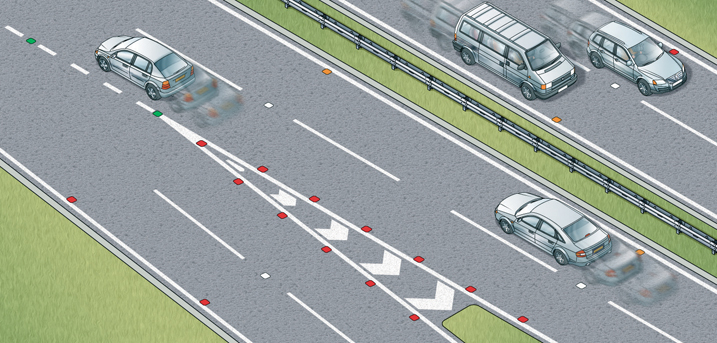
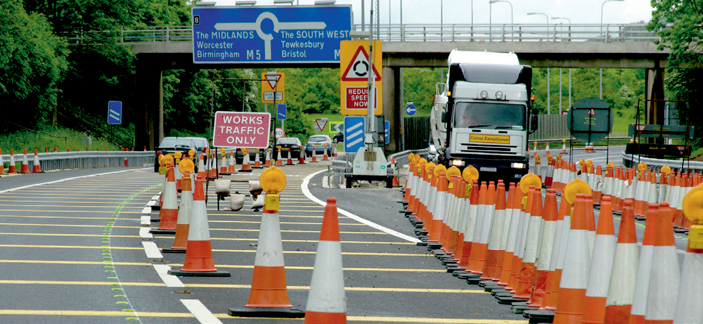
Incidents can often happen at roadworks when drivers fail to observe simple rules of safety. Obey all signs, including speed limit signs.
•Reduce speed in good time when warned by advance warning signs, gantry signs or flashing signals – don’t leave everything to the last minute as this can greatly increase the chance of mistakes and incidents.
•Get into the lane indicated for use by your vehicle in good time.
•Where lanes are restricted, merge in turn.
•When you drop your speed it may seem as if you’re travelling more slowly than you really are – it’s important to observe the speed limit and not just slow down to the speed that feels safe to you.
•Look out for road workers who are placing or removing signs. They might need to cross the carriageway, especially when temporary barriers and cones are being erected or dismantled.
Travelling through roadworks
•Obey all speed limits – they’ve been imposed for a reason. Roadworks are complicated areas and you’ll need more time to spot hazards, for your own safety and the safety of road workers.
•If all drivers observe the speed limits, it helps to keep traffic moving and not ‘bunching up’ – this is good for journey times and the environment.
•Keep the correct separation distance from the vehicle ahead; you’ll need time to brake if the vehicle in front stops suddenly.
•Avoid sharp braking and sudden steering movements.
•Don’t change lanes when signs tell you to stay in your lane.
•Don’t let your attention wander; road workers can appear in unexpected places and can be difficult to spot in cluttered areas.
Exiting roadworks
Stay within the speed limits even when you’re leaving the coned areas. There may be road workers’ vehicles leaving the roadworks at this point. Even if you see the road worker, remember that they may not have seen you. Don’t speed up until you’re clear of the roadworks.
Remember, people may be working at roadworks sites and their safety is at risk if you don’t follow the advice above.
These are temporary systems where traffic travelling in opposite directions shares the same carriageway. They allow traffic to keep moving during repairs or alterations on the other carriageway.
The lanes are often narrower than normal lanes. Red and white marker posts separate traffic travelling in opposite directions and fluorescent or reflective bright green/yellow studs often replace normal ones.
Contraflow systems may also be found on other roads carrying fast-moving traffic.
Watch out for
•lane change signs
•vehicles broken down ahead – there’s often no hard shoulder
•vehicles braking ahead – keep your distance.
Minor maintenance work may sometimes be carried out without the need for major lane closures. Slow-moving or stationary works vehicles, with a large arrow on the back of the vehicle, are used to divert traffic to the right or left as appropriate.
There are no cones or other delineators when these vehicles are being used.
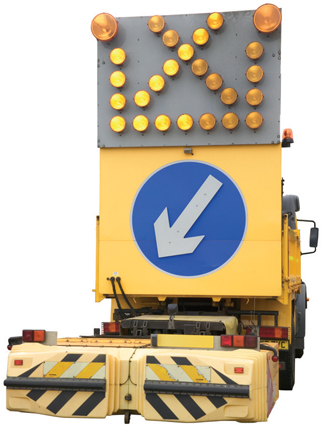
Driving on motorways places greater demands on the driver’s skill, observation, anticipation, planning and concentration. It’s important that you get proper guidance before you attempt to drive on your own on a motorway.
If you’ve recently passed your test, you should take further professional instruction before driving on a motorway. The Pass Plus training scheme aims to improve your driving skills and make you a safer driver, and it includes a section on motorway driving. You can get details of the Pass Plus scheme by calling 0115 936 6504 or visiting www.gov.uk
If you’ve recently passed your test, haven’t driven for a while, or your driving hasn’t included heavy, fast-moving traffic, your decision-making skills might not be up to the standard needed.
You should
•ask advice from a professional instructor who can give you valid, safe instruction
•use every chance to observe and learn as a passenger
•select fairly quiet sections of motorway to practise on
•get used to driving at 60–70 mph (96–112 km/h) and keeping up with the flow of the traffic.
Remember, don’t drive on a motorway until you’re fully prepared. The next move you make always has to be the right one.
Bear in mind that the vehicles on either side and behind you could weigh over 30 tonnes and be travelling at 50–60 mph (80–96 km/h) or even faster.
